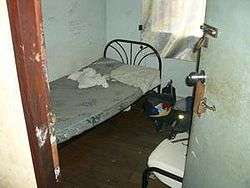Flophouse

A flophouse (US English), doss-house or dosshouse (British English) is a place that offers very cheap lodging, generally by providing only minimal services.[1]
Characteristics
Occupants of flophouses generally share bathroom facilities and reside in very tight quarters. The people who make use of these places are often transients. Quarters in flophouses are typically very small, and may resemble office cubicles more than a regular room in a hotel or apartment building.[2] Some flophouses qualify as boarding houses, but only if they offer meals.
American flophouses date at least to the 19th century, but the term "flophouse" itself is only attested from 1904, originating in hobo slang. In the past, flophouses were sometimes called "lodging houses" or "workingmen's hotels" and catered to hobos and transient workers such as seasonal railroad and agriculture workers, or migrant lumberjacks who would travel west during the summer to work and then return to an eastern or midwestern city such as Chicago to stay in a flophouse during the winter. This is described in the 1930 novel The Rambling Kid by Charles Ashleigh and the 1976 book The Human Cougar by Lloyd Morain. Another theme in Morain's book is the gentrification which was then beginning and which has led cities to pressure flophouses to close.

Some city districts that currently have or once had flophouses in abundance became well known in their own right, such as the Bowery in Manhattan, New York City. As of 2006, building prices and value in the Bowery have significantly increased, and this combined with increased gentrification in the area seriously threatens the ability of flophouses and inexpensive boarding-style hotels to remain open.[3][4]
Cage homes in Hong Kong
Cage homes, described as "wire mesh cages resembling rabbit hutches crammed into a dilapidated apartment", were built in Hong Kong in the 1950s for single working men from Mainland China.[5] As of 2012, the number of impoverished residents in Hong Kong was estimated at 1.19 million, and cage homes, along with substandard housing such as cubicle apartments, were still serving a portion of this sector's housing needs.[5] The combination of high rents and income inequality has been given as one reason that cage homes persist.[6][7][8][9]
Cage hotels in the United States
Cage hotels, a form of single room occupancy, were common in Chicago at the turn of the 20th century; an estimated 40,000 to 60,000 people lived in them during the winter.
These were lofts or other large, open buildings that were subdivided into tiny cubicles using boards or sheets of corrugated iron. Since these walls were always one to three feet short of the floor or ceiling, the open space was sealed off with chicken wire, hence the name “cage hotels."— [10]
A 1958 survey by Christopher Jencks found that homeless men preferred cage hotels over shelters for reasons of privacy and security.[11]
A similar preference for cage hotels over shelters was reported in turn of the century New York City, where single working men ranked their housing preference in the following order:
They preferred lodging and boarding houses to cages, cages to dormitories, dormitories to flops, and flops to the city’s shelters. Men could act on these preferences by moving as their incomes increased.— [12]
"Regulatory efforts to combat low-cost “cage hotels,” ... [has been] a driver of the expansion of the homeless population in U.S. cities," according to Jencks.[13]
Michael Adorjan, a University of Hong Kong criminology professor, has noted that "The United Nations has called cage and cubicle homes an 'insult to human dignity.'"[14]
See also
| Look up flophouse in Wiktionary, the free dictionary. |
References
- ↑ The Last of the Mohicans—Searching for a place to flop on what was once skid row
- ↑ N.Y. Court says flophouses fall under rent stabilization laws
- ↑ From flophouses to fancy on the Bowery from The Real Deal Magazine
- ↑ The Big City; Save the Flophouses
- 1 2 Kelvin Chan, AP (Director) (2013-02-07). "Poor in cages show dark side of Hong Kong boom". NBCNews.com. Retrieved 2013-02-13. Missing or empty
|series=(help) - ↑ Gargan, Edward A. (14 July 1996). "In Rich Hong Kong, Cages as Homes for the Poor". The New York Times. p. 6.
- ↑ Damien Gayle (2012-01-11). "Hong Kong's cage homes: Tens of thousands living in 6ft by 2ft rabbit hutches". Mail Online. Retrieved 2013-02-13.
- ↑ "Hong Kong cage home rents soar above luxury flat". Reuters. 2010-04-28. Retrieved 2013-02-13.
- ↑ Benjamin Gottlieb, Christie Hang (Director) (2011-07-26). "Hong Kong's poorest living in 'coffin homes'". CNN.com. Retrieved 2013-02-13. Missing or empty
|series=(help) - ↑ "Single Room Occupancy Hotels". Encyclopedia of Chicago. Retrieved 2013-02-13.
- ↑ Christopher Jencks. "Housing the Homeless". The New York Review of Books. Retrieved 2013-02-13.
- ↑ Filer, Randall K (1992). "Opening the Door to Low-Cost Housing". City Journal (Summer). Retrieved 2013-02-13.
- ↑ Reihan Salam. "The Agenda: Stephen Smith on the Missing Driverless Trains". National Review Online. Retrieved 2013-02-13.
- ↑ Michael Adorjan (2011-12-21). "Cage homes in Hong Kong: capitalism this Christmas". Retrieved 2013-02-13.
- Jesse Walter Dees (1948). Flophouse; an authentic undercover study of flophouses, cage hotels, including missions, shelters and institutions serving unattached (homeless) men. A sociological study that includes English origins of mass relief, samples of American mass relief and a modern investigation of public and private policies in Chicago. Francestown, N.H,: M. Jones Co. Retrieved 2013-02-13.